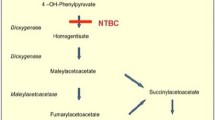Summary
Tyrosinaemia type I is, untreated, a fatal disease: in the acute form from liver failure, in the chronic form often from hepatocellular carcinoma. Acute neurological crisis is also a cause of death. Traditionally the treatment has been with diet, but for a decade liver transplantation has been the ultimate treatment. The continuous production of the pathological metabolites in the kidneys after transplantation appears to be without significance. Introduction of the enzyme inhibitor NTBC in the treatment of tyrosinaemia has reduced the need for liver transplants. Neonatal screening may be justified as efficient treatment has become available. The complex phenotype of lethal albino mice, with severe alterations in gene expression, has been shown to be caused by fumarylacetoacetase deficiency. Prolonged hypoglycaemia in otherwise adequately treated tyrosinaemia patients may result from depressed expression of genes coding for enzymes in gluconeogenesis, as seen in the mouse model. Self-induced genetic correction in liver tissue that occurs in many tyrosinaemia patients may reduce the risk of liver failure in some patients.
Similar content being viewed by others
References
Bergman AJIW, Smeitink JAM, Duran M, Dorland L, Berger R, Poll-The BT (1994) Prolonged hypoglycemia in a patient with adequately controlled tyrosinemia type I.32nd Annual SSIEM Meeting, Edinburgh, Abstract no. 17.
Espteel M, Mandel H, Poggi F, et al (1994) Mosaicism of hepatic peroxisomes in peroxisomal patients.32nd Annual SSIEM Meeting, Edinburgh, Abstract no. 167.
Grompe M, Al-Dhalimy M, Finegold M, et al (1993) Loss of fumarylacetoacetate hydrolase is responsible for the neonatal hepatic dysfunction phenotype of lethal albino mice.Genes Dev 7: 2298–2307.
Holme E, Lindstedt S (1992) Neonatal screen for hereditary tyrosinaemia type I.Lancet 340: 850.
Hutchesson ACJ, Hall SK, Preece MA, Green A (1994) Detection of tyrosinaemia by neonatal screening.32nd Annual SSIEM Meeting, Edinburgh, Abstract no. 73.
Hirschhorn R, Yang DR, Israni A, Huie ML, Ownby DR (1994) Somatic mosaicism for a newly identified splice-site mutation in a patient with adenosine deaminase-deficient immunodeficiency and spontaneous recovery.Am J Hum Genet 55: 59–68.
Kay MA, Woo SLC (1994) Gene therapy for metabolic disorders.Trends Genet 10: 253–257.
Kelsey G, Ruppert S, Beermann F, Grund C, Tanguay RM, Schütz G (1993) Rescue of mice homozygous for lethal albino deletions: implications for an animal model of the human liver disease tyrosinemia type I.Genes Dev 7: 2285–2297.
Kvittingen EA, Rootwelt H, Berger R, Brandtzaeg P (1994a) Self-induced correction of the genetic defect in tyrosinaemia type I.32nd Annual SSIEM Meeting, Edinburgh, Abstract no. 15.
Kvittingen EA, Rootwelt H, Berger R, Brandtzaeg P (1994b) Self-induced correction of the genetic defect in tyrosinemia type I.J Clin Invest 94: 1657–1661.
Laberge C, Grenier A, Valet JP, Morissette J (1990) Fumarylacetoacetase measurement as a massscreening procedure for hereditary tyrosinaemia type I.Am J Hum Genet 47: 325–328.
Lindstedt S, Holme E, Lock EA, Hjalmarson O, Strandvik B (1992) Treatment of hereditary tyrosinaemia type I by inhibition of 4-hydroxyphenylpyruvate dioxygenase.Lancet 340: 813–817.
McKiernan PJ, Preece MA, Green A, et al (1994) Successful treatment of life threatening neurological crisis in tyrosinaemia type I with NTBC.32nd Annual SSIEM Meeting, Edinburgh, Abstract no. 11.
Pérez-Cerdá C, Merinero B, Sanz P, et al (1994) Liver transplantation in nine Spanish patients with tyrosinemia type I.32nd Annual SSIEM Meeting, Edinburgh, Abstract no. 47.
Van Spronsen FJ, Smit GPA, Wijburg FA, Visser G, Heymans HSA (1994) Considerations on treatment strategy in tyrosinemia type I: experiences with risk assessment, diet and transplantation.32nd Annual SSIEM Meeting, Edinburgh, Abstract no. 12.
Wijburg FA, Reitsma WChC, Slooff MJH, et al (1994) Liver transplantation in tyrosinemia type I: the Groningen experience.32nd Annual SSIEM Meeting, Edinburgh, Abstract no. 13.
Author information
Authors and Affiliations
Rights and permissions
About this article
Cite this article
Kvittingen, E.A. Tyrosinaemia — treatment and outcome. J Inherit Metab Dis 18, 375–379 (1995). https://doi.org/10.1007/BF00710049
Issue Date:
DOI: https://doi.org/10.1007/BF00710049




